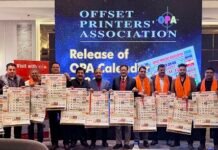At the 450 and 850 setters, exposure speed can be configured individually on the basis of high-performance diode modules, enabling plate throughput rates to be more than doubled. Modular design enables basic models to be upgraded to 4- or 8-page format, for example with Single Cassette Automation (SCA, upto 100 plates) or fully automatic Multi-Cassette Automation (MCA, upto 500 plates). The UV-Setters expose UV sensitive plates for all types of printing presses, and are fitted with an integrated punch. Alternatively, it is possible to work with 3-point plate alignment.
The exposure units of the 450 and 850 are based on basysPrint’s DSI³ technology with high-performance diode modules. Unlike other CtP systems, it uses modules which combine the light output of several diodes installed separately from the exposure head. A compensator bundles the energy and delivers it via fiber optics to the DMD. It is normally not necessary to replace DSI³ modules over the whole service life of the platesetter. A constant light output level is maintained within the modules by way of their APC (Automatic Power Control) circuitry. The DSI³ systems are characterised by a high degree of stability, even without further calibration. Upon request, UV setters can be supplied in traditional lamp versions, above all as an option for companies with a very low plate consumption or for newcomers to the world of CtP.
“The basysPrint systems combine the benefits of CtP with the unique process and economic advantages of the conventional UV plate technology.” said Punch Graphix CEO Wim Deblauwe, “Thanks to their modular concept, the new UV-Setters 450 and 850 can be tailored precisely to individual requirements. Hence, they are also the ideal digital exposure system for high-end users. The systems implement the manifold strengths of both newspaper automation solutions and basysPrint’s proven DSI³ exposure technology, ensuring unrivalled stability and cost efficiency in production.”
Being designed with a flatbed, all versions of the UV-Setters 450 and 850 are able to expose plates of different formats simultaneously. Thanks to the 1-bit TIFF interface, users can freely choose whether to integrate a UV-Setter into an existing workflow system, or to install a dedicated overall solution tailored specifically to individual production requirements. The systems presented at drupa are available with immediate effect through the worldwide network of Punch Graphix dealers.
The company’s large format UV-Setter Series 11, 15 and 16, capable of handling plates up to 1,560 x 3,170 mm, have been enhanced with MCA automation modules as well, allowing for unattended and uninterrupted plate handling. The modules comprise four separate cassettes to facilitate fast loading and unloading of different plate formats. The system can store up to 320 single plates (format up to 1,560 x 3,170 mm, thickness 0.4 mm) or up to 800 dual-loaded plates (two plates in 8-page format, thickness 0.3 mm) as the basis for continuous unattended operation. MCA selects the appropriate plate format for the job in hand, removes the slip paper and transports the plates to the exposure unit. The operator can specify the use of 3-point alignment and/or an integrated punch, which provides for fast, reliable and register-accurate customer-specific punching before exposure. The automation modules MCA or SCA can be retrofitted on site to permit upgrading of existing systems.












